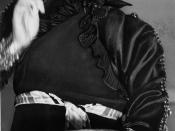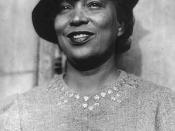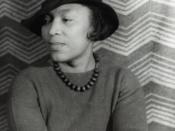Race In Zora Neale Hurston's, "The Conscience of the Court", it is clearly shown that Laura Lee Kimble has at least some awareness of the impact of class and gender in her life. But she does not recognize race and racism as factors that shape her environment and determine her individual identity. For Laura Lee Kimble it is people of color who live racially structured lives.
Race is described as body type, ancestry, cultural differences, biological subspecies, actual social stratification and the normative social stratification. Race according to Michael Masse is: "Body type differences primarily skin color, ancestry as in the U.S., membership in a racial group is defined by the continent in which one's ancestors, prior to the era of European colonialism, were born and cultural differences superficially in preferences over food, dress, music, etc.; more consequentially in religion, levels of civilization and values" (Michael Masse: Concepts of Race and Social Groups, 7).
Hurston's "The Conscience of the Court" examines black women's social position by showing how race and racism shape black women's lives. This is pointed out in the story by Laura Lee Kimble, when she stands in front of the judge and says to him that she does not understand all big words that are being spoken to her. The short story points out race early in the beginning by describing what Laura Lee Kimble looks like and the race that she belongs to. "Though spare of fat, she was built strongly enough, all right. An odd Negro type. Gray-green eyes, large and striking, looking out of a chestnut-brown face" (Zora Neale Hurston, 771). Hurston constructs Laura Lee Kimble's blackness, her race, as a shield that encloses her but does not protect her. Laura Lee Kimble feels that the white man has brought her on trial for something he did and because of her race it is easy to blame her for it. "Charged with felonious and aggravated assault, mayhem and premeditated attempted murder on the person of one Clement Beasley"æI hit the man after he hit me, to be sure, Mister Judge" (Hurston, 770, 771). This shows that a superior race can blame a minority or smaller race for the crimes it commits. Michael Masse describes this as individual harm: "Some people argue that harm can happen only to individuals, not groups. On this view, a harm or injustice inflicted on someone is made more objectionable because it has a racist motive. A racist lynching against an individual is wrong because it is considered a racist motive but if it is done to a group it is made ok, for then it is not considered racist" (Michael Masse: Concepts of Race and Social groups, 17).
This shows that when a single person, of a different race, is blamed for a bad action which he or she did not commit, it is considered bad or racist unless it is blamed on a group of people. By saying different race it means that it is the minority or smaller race that is being blamed for the bad action, just like Laura Lee Kimble is being blamed in the story. Through her characterization of Laura Lee Kimble, Hurston demonstrates that race is not important to many people. She shows that skin color does not matter to Laura Lee Kimble because she thinks that everybody is created equal, despite his or her race. Hurston proves this by telling us a lot about Laura Lee Kimble's background, especially how her childhood had gone by. She shows that Laura Lee Kimble's parents were slaves, yet Laura Lee Kimble herself was not considered a slave because she was too young. She shows that her parent's master do not treat her parents like slaves at all but nearly as friends. Then she goes on to show that Laura Lee Kimble and her present owner, Celestine, considered each other sisters rather than master and slave, even though Celestine was white. This proves that Laura Lee Kimble never believed in race or racism for to her everybody was equal. There is also the element of treatment of a person because of their race. This is proved by showing that any person from a minority or smaller race can be put on trial for bad actions because the superior race hates them and does not believe in equal treatment of races. This is a big issue in Hurston's story because it deals with one race being charged with a bad action, while the judging race is the superior race. Hurston proves that minority or smaller races can win their bad action charges and be proved innocent even though the judging party is a superior race, because the judging party has to look at both sides of a story before deciding the outcome.
Hurston's story has both proof of race and unequal treatment of the minority or smaller race. She also goes on to prove that even smaller or minority races are not guilty of the crimes or bad actions they are blamed for because of their status as being under the superior group. The most important issue is that sometimes even the superior race is at fault.
Works Cited Masse, Michael. Concepts of Race and Social Groups. Boston: Twayne Publishing. 1997.






